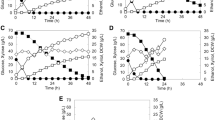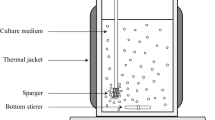Summary
Exposure of methylotrophic yeasts to other carbon sources after growth on methanol results in catabolite inactivation. As a result, peroxisomes are rapidly degraded effectively disabling the metabolic pathway initiated by alcohol oxidase in favour of a more energetically favourable route. A model equation has been developed to describe the effect of temperature, dissolved oxygen concentration and acetaldehyde (catabolite) concentration on catabolite inactivation in Pichia pastoris. When pre-exposed to 4 g/l acetaldehyde at 30°C, the rate of conversion of ethanol to acetaldehyde decreased by 75%. Inactivation was reduced to 45% at 30°C by reducing the dissolved oxygen concentration. At high dissolved oxygen concentration, enzyme function was only inactivated by 20% if the temperature during the period of exposure to acetaldehyde was reduced to 5°C. The influence of acetaldehyde can be eliminated completely by operating at 5°C and low dissolved oxygen concentrations. Application of these findings to process design has enabled us to conduct preliminary reactions in laboratory-scale reactors that have yielded acetaldehyde concentrations greater than 3 M (130 g/l) in 4 h.
Similar content being viewed by others
References
Allais JJ, Louktibi A, Baratti J (1983) Oxidation of methanol by the yeast Pichia pastoris. Purification and properties of the formaldehyde dehydrogenase. Agric Biol Chem 47:1509–1516
Bormann C, Sahm H (1978) Degradation of microbodies in relation to activities of alcohol oxidase and catalase in Candida boidinii. Arch Microbiol 117:67–72
Bormann C, Sahm H (1981) Degradation of peroxisomes in the methanol utilizing yeast Candida boidinii. In: Stewart GG, Russell I (ed) Advances in Biotechnology. Pergamon Press, Toronto, pp 465–470
Box GEP, Draper N (1987) Empirical model building and response surfaces, Chapter 7. Wiley, New York, pp 205–233
Couderc R, Baratti J (1980) Oxidation of methanol by the yeast, Pichia pastoris. Purification and properties of the alcohol oxidase. Agric Biol Chem 44:2279–2289
Duff SJB, Murray WD (1988a) Production and application of the methylotrophic yeast Pichia pastoris. Biotechnol Bioeng 31:44–49
Duff SJB, Murray WD (1988b) Comparison of free and immobilized Pichia pastoris cells for the conversion of ethanol to acetaldehyde. Biotechnol Bioeng 31:790–795
Duff SJB, Murray WD (1989) Oxidation of benzyl alcohol by whole cells of Pichia pastoris and by alcohol oxidase in aqueous and non-aqueous reaction media. Biotechnol Bioeng 34:153–159
Duff SJB, Murray WD, Overend RP (1989) Factors affecting the yeast-mediated conversion of ethanol to acetaldehyde in batch reactors. Enzyme Microb Technol 11:770–775
Egli Th, Dijken JB van, Veenhuis M, Harder W, Fiechter A (1980) Methanol metabolism in yeasts: regulation of the synthesis of catabolic enzymes. Arch Microbiol 124:115–121
Holzer H, Betz H, Ebner E (1975) Intracellular proteinases in microorganisms. In: Horecker BL, Stadtman ER (eds) Current topics in cell regulation, vol 9. Academic Press, New York, pp 103–156
Matile P, Wiemken A (1967) The vacuole as the lysosome of the yeast cell. Arch Microbiol 56:148–155
Murray WD, Duff SJB, Lanthier PH, Armstrong DW, Welsh FW, Williams RE (1988) Development of biotechnological processes for the production of natural flavours and fragrances. Dev Food Sci 17:1–18
Murray WD, Duff SJB, Lanthier PH (1989) Induction and stability of alcohol oxidase in the methylotrophic yeast Pichia pastoris. Appl Microbiol Biotechnol 32:95–100
Murray WD, Duff SJB, Beveridge TJ (1990) Catabolite inactivation in the methylotrophic yeast Pichia pastoris. Appl Environ Microbiol 56:2378–2383
Patel RN, Hou CT, Derelanko P (1983) Microbial oxidation of methanol: purification and properties of formaldehyde dehydrogenase from a Pichia sp. NRRL-Y-113328. Arch Biochem Biophys 221:135–142
Polnisch E, Hofmann K (1989) Cyclic AMP, fructose-2,6-bisphosphate and catabolite inactivation of enzymes in the hydrocarbon-assimilating yeast Candida maltosa. Arch Microbiol 152:269–272
Purwin C, Leidig F, Holzer H (1982) cAMP-dependent phosphorylation of fructose 1,6-bisphosphatase in yeast. Biochem Biophys Res Commun 107:1482–1489
Ramos J, Cirillo VP (1989) Role of cyclic-AMP-dependent protein kinase in catabolite inactivation of the glucose and galactose transporters in Saccharomyces cerevisiae. J Bacteriol 171:3545–3548
Sakai Y, Tani Y (1986) Formaldehyde production by cells of a mutant of Candida boidinii S2 grown in methanol-limited chemostat culture. Agric Biol Chem 50:2615–2620
Sakai Y, Tani Y (1987) Production of acrolein, acetaldehyde and propionaldehyde by cells of a methanol yeast, Candida boidinii. Agric Biol Chem 51:2617–2620
Sakai Y, Tani Y (1988) Production of formaldehyde by detergent-treated cells of a methanol yeast, Candida boidinii S2 mutant strain AOU-1. Appl Environ Microbiol 54:485–489
Tani Y, Sakai Y, Yamada H (1985) Isolation and characterization of a mutant of a methanol yeast Candida boidinii S2 with higher formaldehyde productivity. Agric Biol Chem 49:2699–2706
Tortora P, Birtel M, Lenz AG, Holzer H (1981) Glucose dependent metabolic interconversion of fructose 1,6-bisphosphatase in yeast. Biochem Biophys Res Commun 100:688–695
Tortora P, Burlini N, Hanozet GM, Guerritore A (1982) Effect of caffeine on glucose-induced inactivation of gluconeogenetic enzymes in Saccharomyces cerevisiae. A possible role of cyclic AMP. Eur J Biochem 126:617–622
Toyoda Y, Sy J (1985) Catabolite inactivation of fructose 1,6-bisphosphatase in Kluyveromyces fragilis. Curr Microbiol 12:241–244
Walt JP van der, Kerken AE van (1961) The wine yeasts of the Cape. V. Studies on the occurrence of Brettanomyces intermedius and Brettanomyces schanderlii. Antonie van Leeuwenhoek 27:81–90
Veenhuis M, Zwart K, Harder W (1978) Degradation of peroxisomes after transfer of methanol-grown Hansenula polymorpha into glucose-containing media. FEMS Microbiol Lett 3:21–28
Veenhuis M, Douma A, Harder W, Osumi M (1983) Degradation and turnover of peroxisomes in the yeast Hansenula polymorpha induced by selective inactivation of peroxisomal enzymes. Arch Microbiol 134:193–203
Author information
Authors and Affiliations
Additional information
Offsprint requests to: S. J. B. Duff
Rights and permissions
About this article
Cite this article
Duff, S.J.B., Murray, W.D. & Overend, R.P. Oxygen and temperature effects on acetaldehyde-induced catabolite inactivation in Pichia pastoris . Appl Microbiol Biotechnol 36, 82–86 (1991). https://doi.org/10.1007/BF00164703
Received:
Accepted:
Issue Date:
DOI: https://doi.org/10.1007/BF00164703




